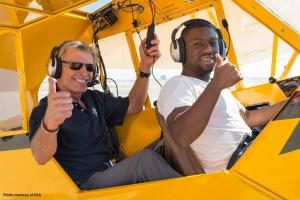During an educational session at NBAA last fall, Seattle-based pilot Mike Rutherford glanced around the room and asked himself, “Where are the 25-35-year-olds?” And, more broadly, “where’s the future of aviation if they’re not in here?”
Instead of just scratching his head and wondering about it, Mike went back to Seattle and actually did something.
He began a grass-roots effort to start mentoring aviation enthusiasts—particularly those who represent the next generation.
For one thing, he started talking up flying and piloting to anyone he came across who showed the slightest interest in it.
He reached out to service professionals he met at Boeing Field, and even approached people he spotted peering through the fence at the airport, hoping to capitalize on their curiosity and enthusiasm.
Mike also got in touch with his son’s high school friends who had expressed an interest in aviation, handing them his business card and encouraging them to get in touch with him.
For those who did call or email him, Mike treated them to a tour of the aircraft and gave them a primer on how to pursue an education and career in aviation.
Planting the Seed
With Mike’s example in mind, I was curious what others might be doing to promote—not just piloting planes—but aviation in general.
So I phoned Derek Popp, a relatively young maintenance technician at Exelon Corporation, to ask him how he got involved in the industry.
As it turns out, Derek’s introduction to aviation came from an uncle of his, who was a maintenance professional for a corporate flight department. It spoke to the importance of family career guidance and “planting the seed” early on to help spark a flame that might swell into a full-blown desire to work in aviation.
Derek also gave me a few important pieces of information about his experience and what others might do to foster it in young people.
- At the young age of 16, he attended the Minnesota Aviation Career Education camp for a week during the summer. It helped familiarize him with all things aviation, and galvanized his interest in the industry.
- He said it’s his belief that young people aren’t as mechanically inclined as they once were, so it’s up to parents to help encourage their children to use their hands to take things apart and put them back together again.
- He told me “I think general aviation gets a bad rap, and the perception is that people in this industry are spoiled or come from affluent families. They don’t realize that corporations use their aircraft as a business tool.”
- Derek advises other aviation professionals to help out at the local airport when they have open houses or “flying days,” and talk to people about what aircraft maintenance is all about.
- He himself reached out to local school guidance counselors to help educate them about the industry and to tell them about the Experimental Aircraft Association (EAA) and its popularity with young people.
Aviation Advocacy
So, with Mike and Derek’s take-charge attitudes as guides, what can a person do to make a difference in helping to promote aviation to young people and help “light the spark” before they’re off to college?
Interest in—and skill with—computers and video games can be a natural stepping-stone to the kind of technologies that aviation consists of.
And, again, not just piloting aircraft—we need to educate young people that aircraft maintenance has become a highly sophisticated and very technological pursuit.
Our aircraft mechanics are no longer merely turning wrenches and getting their hands dirty; they’re training in high-tech avionics and the installation and fine-tuning of highly complex technological components.
The EAA, as Derek Popp advised, is a terrific resource for helping light the aviation spark.
 Founded in 1992, the EAA’s Young Eagles® program has dedicated itself to providing youth (ages 8–17) with their first free ride in an airplane. It’s the only program of its kind, with the sole mission to introduce and inspire kids to the world of aviation.
Founded in 1992, the EAA’s Young Eagles® program has dedicated itself to providing youth (ages 8–17) with their first free ride in an airplane. It’s the only program of its kind, with the sole mission to introduce and inspire kids to the world of aviation.
AOPA High School Aviation Symposiums offer teens another first-rate introduction to flying, aviation mechanics and other facets of the industry. The program takes a three-tier approach to strengthening aviation education in high school science, technology, engineering and math (STEM) programs. AOPA research conducted in the fall of 2014 indicated that, nationwide, there are 240 high schools or other educational programs that include aviation in STEM-based education programs.
For girls and young women, the Women in Aviation (WAI) Annual Conference offers a “Girls in Aviation Day” designed for females ages 10 through 17, to introduce them to aviation or expand their interest in the field.
WAI provides year-round resources to assist women in aviation, and to encourage young women to consider aviation as a career. The organization also offers educational outreach programs to educators, aviation industry members and young people, both nationally and internationally.
Another option for kids who are interested in flight, “aviation camp” might prove to be just the thing they’re looking for.
There are several camps around the country that focus on aviation, but generally, in a weekend- or week-long summer-camp-like atmosphere, they offer instruction in the mechanics of flight and aviation, including flight time and aviation ground schooling geared toward a particular aircraft, such as Cessnas.
Some camps are for middle-schoolers, showing them the basics of aviation and offering fun activities, such as hands-on science experiments. Others are meant for high school and college age kids looking to prepare for a career in aviation, with activities ranging from astronaut training simulators to robotics.
State Initiatives
As I hope you can see, there’s a lot that we, as aviation careerists, can do to help carry the spark of inspiration that we ourselves experienced, and light it in a future generation of aviation professionals.
Whatever state you happen to live in, I would ask you to look into what aviation-focused initiatives may already be available to tap.
If every one one of us pledges to perform at least a single activity to promote flight and aviation to young enthusiasts, then perhaps we can eventually change the alarming trend for pilot (and other aviation professional) shortages we’re now seeing.
Please share this blog with others you think might benefit from it, and, if you have any additional recommendations regarding what we can do, please share them in the comments section below, or email me directly to discuss them.
In next month’s blog, I’ll address ways that we can promote aviation—and the business aviation industry—among our collegiate youth.
PHOTO CREDIT: Special thanks to the EAA. Use of the above photo does not imply EAA’s endorsement, sponsorship or business relationship with API or its products and services.

